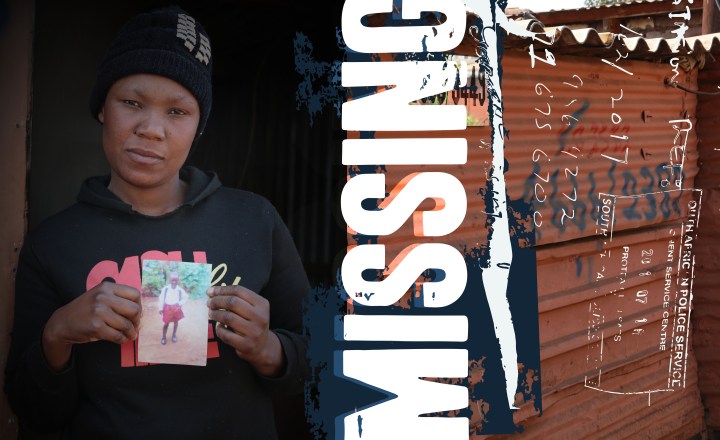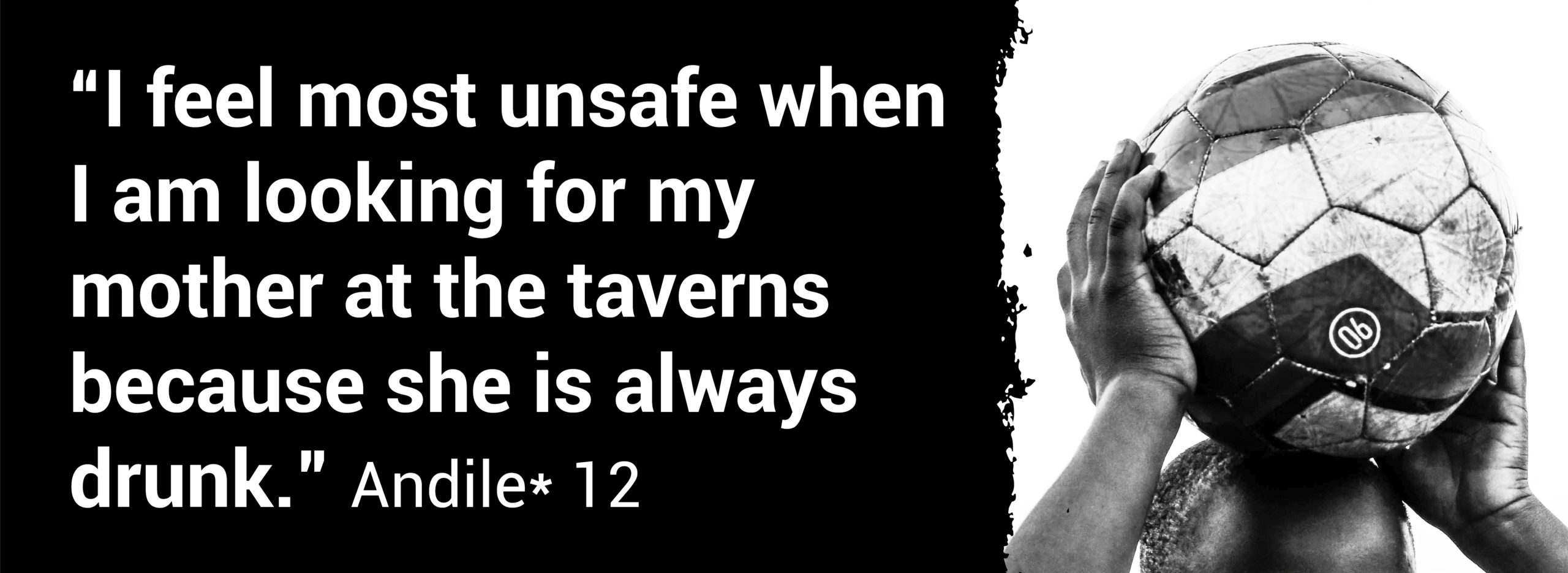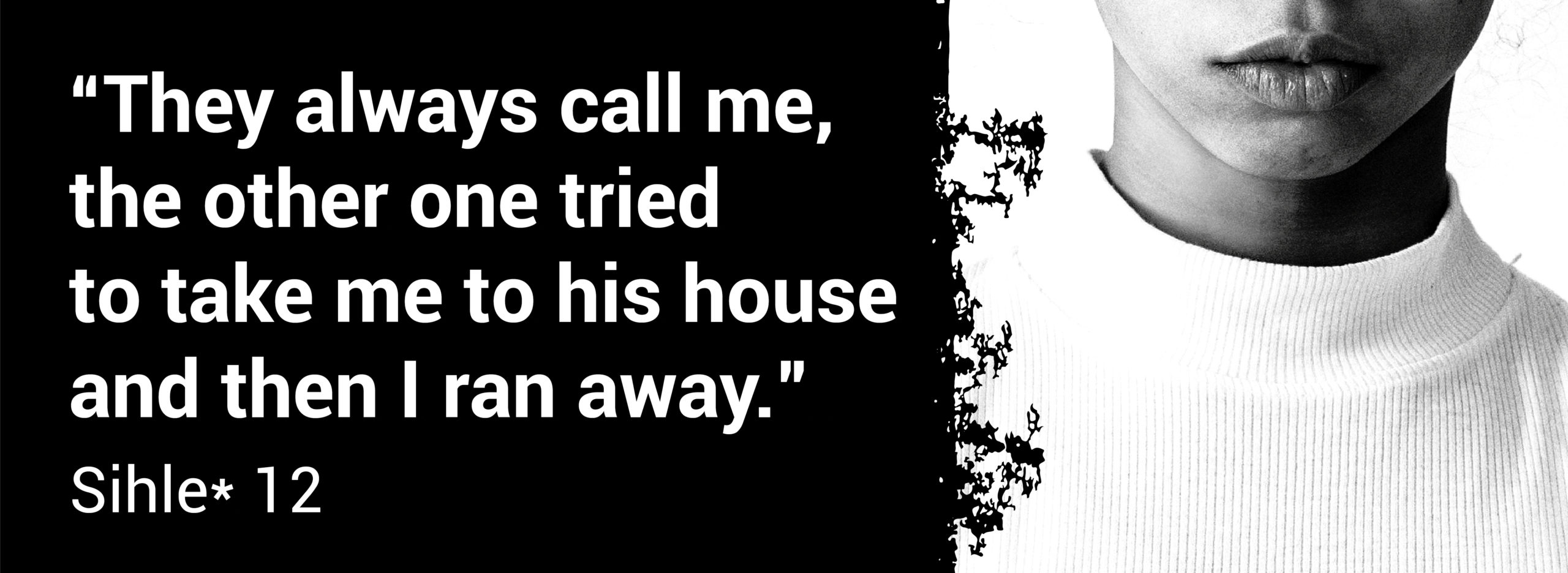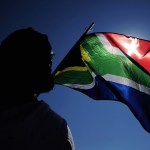OP-ED
South Africa’s missing children (Part One): Myths and misconceptions

Stories of children who go missing, seemingly without a trace, are emotive and fear-provoking. But in a country notoriously poor at child protection, trying to understand a problem often weaponised for political ends seems almost impossible. So just how big is the country’s missing children problem, and how do we unravel the myths and misconceptions that prevent us from understanding it better?
Robyn Wolfson Vorster opted out of corporate life eight years ago to work as a children’s rights activist. You can find her at For the Voiceless or her website, Becoming a Mom.
In August 2017, Marilyn Bassin, a physiotherapist working in Protea South squatter camp in Soweto, was confronted by a distraught young mother holding a photo of her six-year-old daughter Akani, who had gone missing in February that year. Promising to follow up, Bassin met with the station commander at the police station where Akani’s disappearance had been reported.
“He admitted that there was no news about Akani’s case”, she explains. “Then he showed me a 25cm high pile of files sitting on a desk. He said that each one needed following up. They were all missing children. He told me that the babies had probably been taken by childless mothers, the teens were considered runaways, and those in between may have been taken for muti”.
Four years later, Bassin returned to find that Akani was still missing. This time, her visit to the police station was starkly different. “Although investigating officers stated that they received about two missing children cases per month,” Bassin said, “in the commander’s absence, the acting head told me that there were no missing children cases at the unit, and that most missing children were runaways, who come back.”
Bassin’s experience at one police station highlights the complexity of missing children in South Africa, and the lack of clarity about how big the problem is, a challenge that makes it even more difficult to solve. It also mirrors a larger debate around the link between missing children and trafficking, and if South Africa has a problem with child trafficking.
During September 2020, South Africa was subjected to an unprecedented barrage of reports about child kidnappings and trafficking after an incident at a Johannesburg restaurant where a perpetrator tried to snatch a four-year-old girl while she ate lunch with her mother. Although he was found to be mentally unstable and acting on his own, social media was soon flooded by stories of children narrowly avoiding kidnapping after being dragged out of cars, or targeted on the street.
Whatsapp, Facebook and Telegraph messages, always issued by unnamed but seemingly credible sources, warn parents of imminent danger to their children, the importance of being vigilant, and the terror of organised child trafficking syndicates allegedly run by Nigerian or Chinese foreign nationals.
The resultant frenzy, also fuelled by a global upsurge in trafficking disinformation ahead of the 2020 American elections and driven by right-wing group QAnon, and the highjacked hashtag, #savethechildren, culminated in claims that in South Africa, a child is kidnapped for sex trafficking every 30 seconds, and in a local celebrity tweeting that a million South African children are trafficked annually.
The figures were widely debunked, but when the panic didn’t abate, police spokesperson Brigadier Vishnu Naidoo issued a statement emphasising that while cases of kidnappings, abductions and missing persons are of serious concern to the police, “human trafficking is not prevalent in South Africa, as it is in other parts of the world.”
Naidoo’s messaging is contradicted by other parts of government, however. In 2016, the Department of Home Affairs (DHA) issued a controversial directive requiring children to carry their unabridged birth certificate with them for all cross-border travel to combat the 30,000 children it claimed were trafficked through the country every year.
The DHA wasn’t able to validate its numbers, but it isn’t the only government department to use trafficking to justify changes in policy. In 2020, the Department of Social Development (DSD) stated that “there is a fine line between adoption and the sale of a child” to justify anti-adoption policy. The department’s legal advisor then went on to use global missing children statistics to link trafficking and missing children, and justify children staying in South Africa, because they are safer here.
What’s evident is that the issue of missing and trafficked children is complex and hidden and that myths and misconceptions abound. The biggest are:
One million South African children are trafficked every year
Fact-checking organisation Africa Check found no evidence to support the claim that one million children are trafficked out of South Africa annually. While actual numbers are elusive, figures cited by a 2007 Unesco report are that 1.2 million children were trafficked globally. The 2017 Alliance 8.7 Global Estimates of Modern Slavery, estimates that there are one million child sex trafficking victims globally, and four million child trafficking victims in total, making the inflated number of South African children implausible.
South Africa doesn’t have a problem with trafficking
However, the complexity of the problem is clear in the same Unesco report which names South Africa as “a source, transit, and destination country for men, women, and children trafficked for forced labour, sexual exploitation and organ harvesting”. In other words, trafficking, including trafficking of children, happens into, within, and out of the country.
In 2007, it was estimated that 247,000 children were working in exploitative labour in the country, including 30,000 child prostitutes.
As recently as 2020, A21 — a global anti-trafficking organisation — received 4,847 contacts on its South African helpline. 34.8% of reports involved children. It identified 696 potential trafficking victims, 71% were South Africans.
A21 also reports that 64% of trafficking victims in Africa are children. According to child welfare, South Africa’s social and economic challenges including inequality, unemployment, lack of education, and poverty, make it a fertile ground for child sexual exploitation and trafficking.
The 2021 Trafficking in Persons Report is even more specific, describing how traffickers in South Africa recruit victims from poor neighbouring countries or locally from deprived or rural areas, and exploit them in sex trafficking in urban areas. Victims include children as young as 10.
In addition, traffickers force adults and children into labour in domestic service, mining, begging, street vending, food services, criminal activities, agriculture, and the fishing sector.
All missing children are trafficked
A21 describes human trafficking “as the exploitation of both the victim’s body and labour amounting to modern-day slavery”, a definition that Senior State Advocate Dawn Coleman-Malinga, Chairperson of the KwaZulu-Natal Human Trafficking, Harmful Traditional Practices, Prostitution, Pornography and Brothels (HHPPB) task team, expands on: “exploitation includes the removal of body parts (for muti purposes), child labour and sexual exploitation. Trafficking in Persons (TiP) also includes forced marriages and illegal adoptions for purposes of exploitation.”
According to Dr Marcel van der Watt, a former member of the Hawks with almost 20 years’ experience in human trafficking and organised crime, now from the National Center on Sexual Exploitation, “not all missing children are trafficked, but many trafficked children are missing”.
Bianca van Aswegan from Missing Children SA concurs, “not all missing children are trafficked. Some are lost, others are mentally challenged children who have wandered off, some are runaways, others family abductions or even kidnappings for ransom.”
Many anti-trafficking NGOs believe that only 1% of trafficking victims are found. This means that while most of the missing children who are found safely or return home after being reported missing were probably not trafficked (77% according to Missing Children SA’s statistics), the 23% who are not found or found deceased, may have been. And a child away from home for any reason can become vulnerable to trafficking.
A child goes missing every 10 hours
Despite requests to the South African Police Service (SAPS) for clarification about how many children are reported missing in South Africa annually, no recent figures were available at the time of publishing. However, unaudited SAPS statistics indicate that in 2016, 866 children were reported missing (down from 1,697 in 2013). This amounts to a child going missing every ten hours.
But, according to the country’s Missing Person’s Bureau, this stat is misleading because some children are found almost immediately.
Equally concerning, though, is the under-reporting of missing children. So, while the SAPS is rightly concerned about statistics creating “fear and pandemonium”, the number of children who are missing is likely far higher than reported.
All missing children are runaways who return
Van Aswegan acknowledges that most Missing Children SA’s cases are runaways. But she urges us to “chase the reason”. While some may be running away to be with a boyfriend or for drug use, others leave because of fear or violence.
In a series of interviews conducted with children by community leaders and social workers across three provinces, the Western and Eastern Cape, and Gauteng, most children identified home as being their safest place. But in sharp contrast, others disclosed how unsafe they feel at home, speaking about parents who drink, take or deal in drugs, and about accompanying abusive behaviour.
Van Aswegan tells the story of a 16-year-old runaway who was found hiding under a bridge because her father raped her.
The typical ‘missing child’
Misinformation has distorted our image of the “missing child” to, on one extreme, the #savethechildren narrative of wealthy children being snatched off the streets, and on the other, that only poor and vulnerable children go missing. Both are problematic.
Figures provided by the SAPS indicates that 58% of missing children are female, 42% male, and that 83% are African, followed by 10% Coloured children and 5% white.
Although figures bear some resemblance to the country’s demographics, the disproportionately high number of black children is likely poverty-related, especially in trafficking cases. However, poverty isn’t the only risk factor for children.
In 2020, the annual GloTiP report produced by UNODC analysed 99 child trafficking court cases and found that economic need was a factor in 40% of cases, that the child came from a dysfunctional or abusive family in 36% of cases, and that in 18% of cases the child was deprived of parental care, this included children in institutions. Immigration status was a factor in 9% of cases.
The report concluded that “a child victim’s vulnerabilities are often connected to the child’s family background. In extremely poor communities, socioeconomic context and cultural norms play an important role in the trafficking of children. However, even in high-income countries, children are vulnerable to traffickers. This is particularly true among children experiencing dysfunctional parenting or with no parental care, as well as those living in poorer communities.”
The violent kidnapping
The indicators of what makes children vulnerable challenge another myth — that of violent kidnapping. While these do occur, they often draw unnecessary attention to the kidnapping. Where syndicates are involved, they commonly move children often to cover their tracks.
Nor is a violent kidnapping always necessary. South Africa is a country where victims are easily targeted, and crimes are often opportunistic rather than orchestrated.
Poor and vulnerable children are particularly accessible. During interviews in a Johannesburg squatter camp about what makes them feel unsafe, children responded that they were most fearful at the local river, a favourite spot for children to play house despite it being hidden from the shacks and notorious for rape and murder. Others, as young as nine years old, expressed how fearful they are when out alone at night, either playing unsupervised after dark or because they had been left at home alone.
Of the children surveyed, only a handful had been given any advice about how to stay safe.
Sihle*, 12, who was born with albinism, is terrified of being kidnapped for muti. Normally confident, she squirms in anguish when describing how a man called her and tried to take her when she was out on the streets playing.
Andile* also 12, who presented as openly homosexual from toddlerhood, is regularly preyed on by adult men in the community. He expresses the fear of having to find his mother at night at the local tavern after she has gone out drinking.
It’s also easy to exploit poor people with offers of help, and even food. A review of child kidnapping cases in the media shows some common themes. One is perpetrators using the victim’s need to lure them.
Newborns are often kidnapped by the “kind stranger”. Stories abound of kidnappers appearing to take pity on a new mom and offering to help with lifts, getting her a child support grant, much-needed supplies like nappies or baby clothes, or even, in one case, offering to buy the new mommy a pair of tackies so she didn’t have to wear slip-slops in winter.
All these stories end with the kidnapper holding the baby while the mom buys food or clothing, and then disappearing.
Small children are also enticed using treats. Many of the missing children cases reported in the media involve a child taken to a tuck shop for chips, or children offered sweets.
In the North West province, three little boys were allegedly lured into a Volkswagen Polo with the promise of chips. One told police that he’d escaped, but the other two boys, Onalenna and Gontse, both aged 10, were found drowned in the pool of a local house being rented by foreign nationals two days after they were reported missing.
In rural KwaZulu-Natal in 2020, Nqobile* and Nothando*, aged five and nine, narrowly escaped being killed for muti after they were lured with the offer of sweets. When the children didn’t come home and efforts to find them proved unsuccessful, quick action by their mother led police, with the help of sniffer dogs, to find them in the home of a local sangoma at 10pm on the night they went missing. They were tied up, locked in a room and heavily sedated.
It was days before the dazed children were able to tell their story. They said that they remembered being called across to the man who said he wanted to buy them something. They went to him and then everything went pitch black. They couldn’t remember anything after that.
According to child welfare, this doesn’t only occur with smaller children. Older children are often lured into sex slavery through promises of a better education and jobs, family protection and economic support for themselves or their families. Others are ensnared through “survival sex”, where sex is exchanged for basic necessities such as food, shelter, education, or to settle a debt owed by a family member.
Even affluent children, targeted online, are usually groomed and lured with currency, often someone willing to listen or give them affection. Van der Watt explained that while gathering criminal intelligence as a police investigator, he spoke to numerous pimps and traffickers who boasted about using social media to “work on” multiple girls at a time for recruitment into the sex trade. One of them boastfully mentioned “more than 70 girls” he was communicating with on platforms such as Facebook and Twitter.
Anecdotal evidence indicates that the “violent kidnapping” story is most prevalent when a specific child is being targeted or when the kidnapping story has been fabricated.
In May 2020, Alexia Nyamadzawo’s mother reported that her daughter had been snatched from the backseat of her car. But after a province-wide search found the six-year-old’s body in a sugar cane field, police discovered that her mom had killed her daughter and covered it up with the story that she was kidnapped.
By contrast, Amy Leigh de Jager, who was snatched from her mother’s car outside her school in 2019 and whose kidnapping for ransom was orchestrated by a Grade RR teacher at her school, was specifically targeted, as was Gabisile Shabane, a child with albinism who was kidnapped for muti from her home in Hlalanikahle in 2018.
But other children may be selected randomly in a more opportunistic way or through relationships. In one tragic story, a little boy was kidnapped because he lived next door to the sangoma who wanted to use a child’s body parts for muti.
Stranger danger
Stories of opportunistic kidnapping and murder of children call into question another myth associated with missing children, that of “stranger danger”. It’s a problem with narratives coming out of QAnon, where the enemy is externalised, namely a shadowy global cabal of paedophiles. But this doesn’t acknowledge that intimate partners, family and community members are frequently identified as abusers, kidnappers or human traffickers. The focus “renders real traffickers and survivors invisible” and means that we’re looking for danger in the wrong place.
When asked what they had been taught about keeping safe, almost 50 children from the Eastern and Western Cape said that parents and teachers had told them to be careful of strangers. But, evidence shows that children are more likely to be taken by someone they know.
This applies to individuals and groups. In Fochville in 2020, 29 children went missing, 15 for an extended period, when their soccer coach, described by one of the children’s parents as “an approachable person”, who had formed the sports team to “keep the children out of trouble”, put them in a bus so they could play a tournament in a nearby town. They didn’t return. Children were separated, some left in the veld, others taken to an informal settlement and others to a hotel. Reports state that some of the children were drugged and others sexually assaulted while in the care of the man. Parents interviewed said they had “no reason to believe he would want to harm their kids”.
Children themselves acknowledge intimate family member and community danger. In a squatter camp in Johannesburg, children as young as three teach others a Sesotho self-help song complete with actions, which roughly translated is: “Uncle, if you touch me inappropriately, I’ll call the police. They will come with their sirens, and handcuff you and you will be arrested.”
The 24-hour waiting period
A number of the missing children stories featured in this series involve families told to wait before reporting their child missing. But there is no waiting period for reporting a missing child. Given that the golden window for finding them is 24-48 hours after their disappearance, the sooner the police are called, the better.
Child trafficking elicits horror and compassion which is why it is often deployed to fuel a political agenda. It’s a tactic effectively applied by QAnon and #savethechildren through its “QAmom” strategy which uses the fear of child trafficking and paedophilia to recruit new adherents to its right-wing agenda, ironically redeploying funds away from vulnerable children and overburdening limited policing and helpline resources with unverifiable incidents.
It’s one of the main reasons why Q and #savethechildren banners have been so prominent during anti-lockdown rallies including in South Africa, as followers have gone so far as to label Covid-19 a hoax designed to cover up child sex trafficking.
It epitomises the problem. Disinformation detracts from very real challenges children are facing through the pandemic, including escalating abuse at home, increased vulnerability as poverty gets worse, ongoing rotational learning leaving children at home alone, more unsupervised online time, and fractured support systems because of lockdown measures.
The same is true when trafficking is weaponised for a political goal.
In South Africa, rhetoric inflating or diminishing the threat of child trafficking has been used for a myriad of objectives: to promote changes to immigration and adoption policies by government, but also to fuel xenophobic violence, to empower lobbies to decriminalise the sex trade and to guide policy around migrant children.
However, while trafficking is a prominent part of public discourse, South Africa was downgraded to a Tier 2 watchlist country in the 2021 US State Department’s trafficking in persons report, indicating that it doesn’t fully meet the minimum standards for the elimination of trafficking, but is making significant efforts to do so. It’s a step backwards for the country and a failure which is more glaring when confronted with the victims.
Behind each statistic — both those recorded and those who will never be listed as missing or trafficked — is a child, like Akani, many of whose voices are muted. This is especially true of those found dead or are still not found.
In the next article in this four-part series on Missing Children: Ðead, or still not found, we tell their stories. DM
These articles focus on children who have gone missing, on survivors and those not found or found deceased. While the names of survivors and their parents have been changed to protect their identities, the names of children still missing are included, along with photos and missing person’s posters in the hopes someone knows where they are. If you have any information, please contact Bianca van Aswegan from Missing Children SA on 072 647 7464 or SAPS Crime Stop on 086 000 10111.
This story was published with the support of Media Monitoring Africa and Unicef as part of the Isu Elihle Awards Initiative.























 Become an Insider
Become an Insider
Comments - Please login in order to comment.